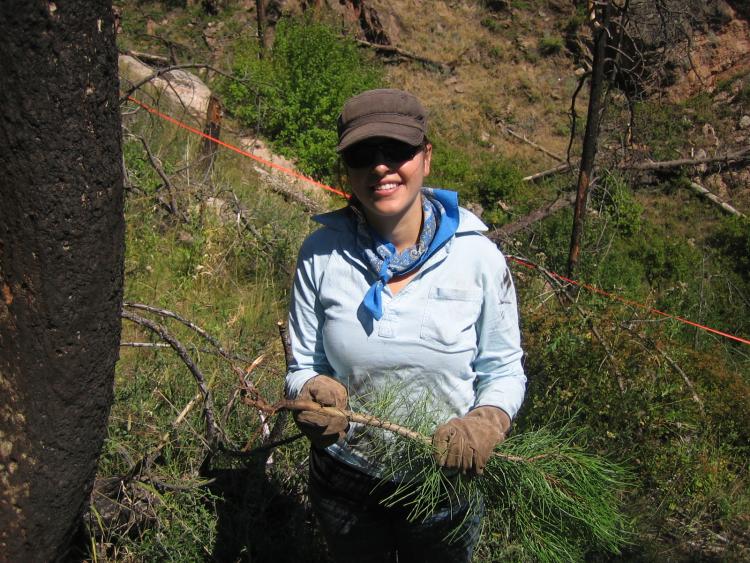Forest regrowth tends to be thinner after wildfire
A changing climate is making it harder for forests to re-establish themselves at their former densities, CU Boulder doctoral student finds
Wildfires may soon change forests in the Colorado Front Range, thanks to shifting precipitation and temperatures driven in part by climate change, according to new research from the University of Colorado Boulder’s Biogeography Lab.
“Many areas that burned are not recovering following fire, and we expect these areas to stay more open, either as grasslands or more open savannas with sparse trees,” said Monica Rother, about forest regeneration in the lower montane zone, which is the “lower timberline,” generally between 6,500 to 7,300 feet, that separates the drier grassland plains from the mountain forests.

Monica Rother holds a harvested ponderosa seedline at Hail Valley Ranch Open Space, in an area hit by the 2003 Overland Fire. Photo by Lisa Trope. At top of page, Rother looks over a live seedling at Walker Ranch Open Space in the area hit by the Walker Ranch Fire of 2000. Photo by William Foster
The study, “Climate Drives Episodic Conifer Establishment after Fire in Dry Ponderosa Pine Forests of the Colorado Front Range, USA,” examined five recent Front Range fire areas: the High Meadows, Hayman and Buffalo Creek fires, and the 2003 Overland and 1988 Canyon fires in Boulder County. The study areas were selected largely based on the elapsed time from the fire, generally between 10 and 24 years, giving the forest time to regenerate.
“We do see fire as acting as a catalyst for forest change, whereas those areas would change more gradually under a climate-warming scenario (without fire),” said Rother, who earned her doctorate in geography in 2015 and whose study was published in the May edition of the journal Forests. “On a twisted silver lining, fewer trees could mean less fire danger for people who live in these areas.”
Researchers examined seedlings from the high-, moderate- and low-intensity burn areas of the fires to establish exactly when those seedlings took root. After ascertaining what year the seedlings took root, the research then correlated those results with three main factors affecting tree seedling establishment: precipitation, temperature and the Palmer Drought Severity Index (PDSI), which is a measure of drought that combines temperature and recent precipitation.
“Essentially, we first just looked to see pulses of activity (in years with higher precipitation and possibly lower temperatures),” Rother said. “Establishment does tend to happen in these years with higher precipitation and positive PDSI values.”
While rising temperatures are likely under climate change, decreased precipitation is not, according to studies cited in her research. Increased evapotranspiration, or the evaporation of water, under warming scenarios, however, would decrease the amount of water available to seedlings, Rother noted, even if precipitation remains constant.
In addition, her previous research of seedling mortality under controlled conditions indicates that increased temperatures—given similar water conditions—should have a detrimental effect on forest regeneration.
Rother’s past research on Ponderosa Pine and Douglas Fir forests, trees both common along the Colorado Front Range, indicated that the severity of the fire appeared to have less of an effect on regeneration than the availability of water. However, larger fires in the lower montane often mean there are large open areas where mature, seed-dispersing trees are simply too far away to naturally regenerate the interior of the area affected by fire.
“A lot of land managers tend to focus on the severity of the fire, but we found the distance to the seed source was more important,” Rother said.
The Biogeography Lab—and its director, Thomas T. Veblen, a Professor of Distinction in the geography department—is continuing the study of post-fire forest regeneration with new studies in southern Colorado and northern New Mexico. Veblen was also a co-author in the recent article that appeared in Forests, and he noted that higher-elevation forests are showing similar regeneration problems.
“Studies conducted at high elevations near treeline in the Colorado Front Range also show that warmer temperatures are limiting tree seedling establishment to infrequent years of above-average precipitation,” Veblen said.
“When those results are combined with the observations of reduced rates of tree regeneration following fire, the implication is that under continued warming trends we expect to see less dense forests and in some places shifts from forests to non-forest vegetation types.”
Rother is now a fire ecologist at the Tall Timbers Research Station & Land Conservancy in Florida.

